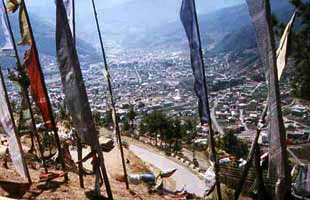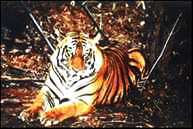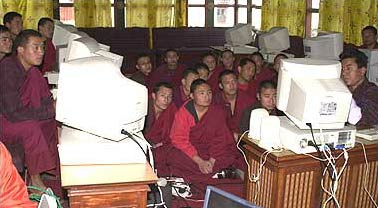| Bhutan
Country Information |
 |
Bhutan Information |
|
|
 |
| Urbanisation
encroaches on agriculture |
 |
 |
Thimphu
In
the last four years, Bhutan has lost 629.91 acres of wetland to infrastructure
development and land conversion. This does not include illegal conversions,
flood affected, or abandoned wetland areas.In six dzongkhags - Thimphu,
Wangduephodrang, Trashiyangtse, Trashigang, Chukha, and Punakha - construction
of infrastructure like schools, power projects, roads, housing, and town
have swallowed 583.33 acres of wetland. Thimphu alone lost 401.42 acres,
Wangduephodrang lost 48.94 acres, Chukha lost 37.11 acres, and Punakha
lost 84.92 acres of wetland. |
This
trend could have serious consequences on the national objective of achieving
70 percent self sufficiency in food production. In fact, it contradicted
the policy of increasing food production.
For
example, it had become difficult to adopt mechanised farming because mostly
flat land was being lost and food production, particularly rice, had reduced.Thimphu
farmers said that paddy production had fallen steadily over the years and,
on an average, each farmer in Babesa lost about an acre of wetland to the
Changjiji housing project and the expressway, excluding apple orchards
and other land holdings. Ap Lotey of Babesa, who lost a little over an
acre of wetland from which he used to harvest about 1,200 kilogrammes of
rice, said that he would prefer land over money because it was non-perishable.
Ap Rinzin who lost about 150 apple trees to the expressway and about 1.5
acres of paddy land says he will not be able to produce enough food grain
for his family.
With
Bhutan's rising population, the increased import of food commodities would
leave the country more vulnerable in terms of food sufficiency. There are
many cases still of wetland conversion that the authorities are not aware
of. This is really going to be a big challenge because Bhutan is losing
agrarian land left and right. Only 7.8 percent of Bhutan's land area was
suitable for agriculture and just a fraction of that was wet land. Arable
land, which totalled 53,200 acres, could not be expanded because of the
policy of maintaining 60 percent forest cover.
Bhutan's
Land Act was enacted in 1979 to protect wet land and, over the years, a
number of amendments has been made. The act forbids the conversion of wetland
without the approval of the ministry of agriculture. The lack of commitment
to the act had resulted in varying interpretation of the law, inflicting
a serious setback to fertile agricultural land. Meanwhile, about 70 percent
of the population own less than five acres of agriculture land per household
and that was being fragmented among families. Bhutan has to consider
establishing population centres away from flat agriculture land, experts
says. According to theses experts constructing infrastructure and other
development projects among the surrounding hills would not have been very
difficult.
top
| 'Vision
and strategies' for protected areas |
 |
Bhutan
today has four national parks (Royal Manas National Park, Jigme Dorji National
Park, Black Mountains National Park, Thrumshingla National Park), four
wildlife sanctuaries (Bomdeling Wildlife Sanctuary, Sakteng Wildlife
Sanctuary Khaling/Neoli Wildlife Sanctuary, Jigme Khesar Strict Nature Reserve (former Toorsa Strict Nature Reserve))
and a nature reserve which make up about 26 percent of the country's area.
Apart from several endangered species of flora and fauna, 7,000 species
of plants, 165 species of mammals and 700 species of birds can be found
in the forests of Bhutan which cover 72 percent of the country's area.
 |
A Bengal tiger was sighted at the Thrumshingla N.P., 3,000 metres a.s.l.
Two
years ago a 'biological corridor' was created to link the protected areas
to prevent the 'genetic erosion' of plants and animals. Conservation
of the natural environment has always been a priority of the royal government.
The new vision and strategy document, he said, will ensure a more focused
approach and also take into account emerging conservation issues in the
management of the protected areas. |
The
document, among other things, will set conservation goals, give direction
and incorporate the changing role of the nature conservation division.
While lack of adequate communication among various stakeholders, human
wild life conflicts, poaching, inadequate human and financial resources
and forest fires have been identified as major problems, the richness of
biodiversity, strong political donor support, potential for eco-tourism
and research opportunities are outlined as opportunities. Although a protected
area system was established since the early 60's most of the areas were
confined to the northern and southern belts.
Apart
from several endangered species of flora and fauna, 7,000 species of plants,
165 species of mammals and 700 species of birds can be found in the forests
of Bhutan which cover 72 percent of the country's area.
top
| Central monk body has begun teaching computer operations |
 |
 |
The
central monk body has begun teaching computer operations to monks in its
bid to electronically archive Bhutan's rich collection of Buddhist manuscripts,
biographies and historical documents. The first step to archive religious
documents electronically has begun: monks learning computer operations
20
monks of the central monk body completed a two-week (Level 2) computer
operations course conducted by the National Technical Training Authority
(NTTA) under its special skills programme. |
Using
Dzongkha fonts with Microsoft word, typing, editing and formatting in Dzongkha,
typing pechas (scripts) and using templates for pechas, printing techniques,
and introduction to internet were some of the skills imparted to the trainees.
With
this training the monks will be able to save all scripts in computers and
maintain it in a CD as a back up storage, NTTA officials said. The central
monk body has already purchased 12 computers and will soon buy another
eight to begin archiving. "This project was personally initiated and funded
by His Holiness the Je Khenpo," said project coordinator, Karma Lhendup
of the central monk body. His Holiness contributed Nu 1.8 million to the
project.
To
start with, the Drukpa Kagyued text will be compiled first. "Some portions
of the text have been lost," said Karma Lhendup. "For example some pages
of the Tsangpa Jarey kabum are missing but we have borrowed the text from
buddhist monasteries in India and Nepal to fill in the missing bits and
make corrections where necessary."
He
added that other rare Buddhist texts which once existed in Bhutan but are
now lost will also be borrowed and archived. Important religious texts
of other major Buddhist lineages like the Nyingma tradition will be compiled
at a later date. "When we complete compiling, our archive will be accessible
to the public and those interested in research," said Karma
Lhendup.
The
National Library also has a similar project to document religious texts
in the country.
| Information on Bhutan |
 |
|






